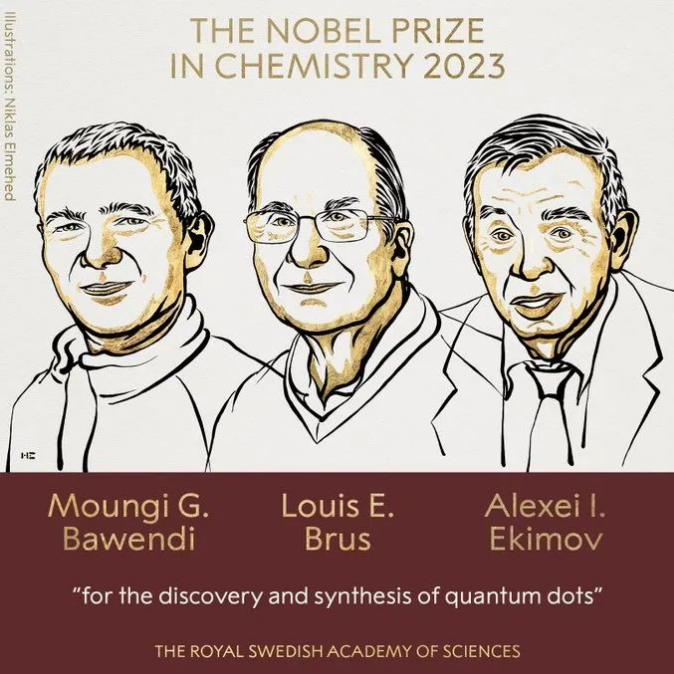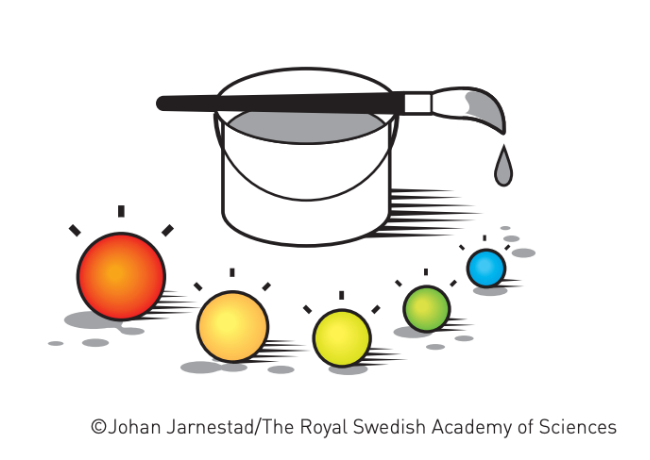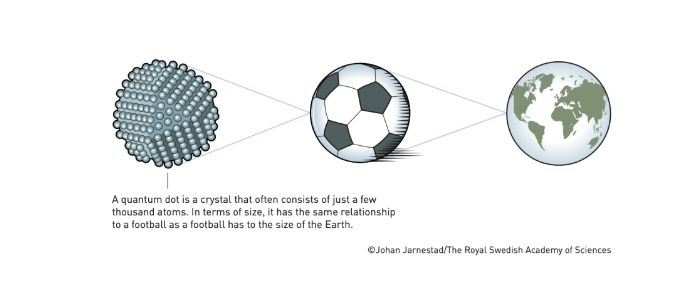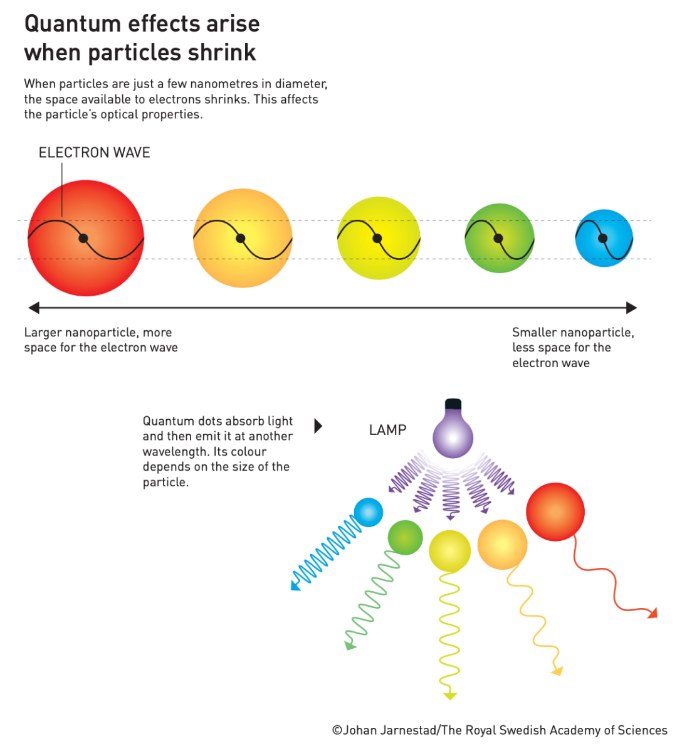


4 October 2023
The Royal Swedish Academy of Sciences has decided to award the Nobel Prize in Chemistry 2023 to
Moungi G. Bawendi
Massachusetts Institute of Technology (MIT), Cambridge, MA, USA
Louis E. Brus
Columbia University, New York, NY, USA
Alexei I. Ekimov
Nanocrystals Technology Inc., New York, NY, USA
“for the discovery and synthesis of quantum dots”
The Nobel Prize in Chemistry 2023 rewards the discovery and development of quantum dots, nanoparticles so tiny that their size determines their properties. These smallest components of nanotechnology now spread their light from televisions and LED lamps, and can also guide surgeons when they remove tumour tissue, among many other things.
Everyone who studies chemistry learns that an element’s properties are governed by how many electrons it has. However, when matter shrinks to nano-dimensions quantum phenomena arise; these are governed by the size of the matter. The Nobel Laureates in Chemistry 2023 have succeeded in producing particles so small that their properties are determined by quantum phenomena. The particles, which are called quantum dots, are now of great importance in nanotechnology.
“Quantum dots have many fascinating and unusual properties. Importantly, they have different colours depending on their size,” says Johan ?qvist, Chair of the Nobel Committee for Chemistry.
Physicists had long known that in theory size-dependent quantum effects could arise in nanoparticles, but at that time it was almost impossible to sculpt in nanodimensions. Therefore, few people believed that this knowledge would be put to practical use.
However, in the early 1980s, Alexei Ekimov succeeded in creating size-dependent quantum effects in coloured glass. The colour came from nanoparticles of copper chloride and Ekimov demonstrated that the particle size affected the colour of the glass via quantum effects.
A few years later, Louis Brus was the first scientist in the world to prove size-dependent quantum effects in particles floating freely in a fluid.
In 1993, Moungi Bawendi revolutionised the chemical production of quantum dots, resulting in almost perfect particles. This high quality was necessary for them to be utilised in applications.
Quantum dots now illuminate computer monitors and television screens based on QLED technology. They also add nuance to the light of some LED lamps, and biochemists and doctors use them to map biological tissue.
Quantum dots are thus bringing the greatest benefit to humankind. Researchers believe that in the future they could contribute to flexible electronics, tiny sensors, thinner solar cells and encrypted quantum communication – so we have just started exploring the potential of these tiny particles.
The illustrations are free to use for non-commercial purposes. Attribute ”? Johan Jarnestad/The Royal Swedish Academy of Sciences”



Moungi G. Bawendi, born 1961 in Paris, France. PhD 1988 from University of Chicago, IL, USA. Professor at Massachusetts Institute of
Technology (MIT), Cambridge, MA, USA.
Louis E. Brus, born 1943 in Cleveland, OH, USA. PhD 1969 from Columbia University, New York, NY, USA. Professor at Columbia University, New York, NY, USA.
Alexei I. Ekimov, born 1945 in the former USSR. PhD 1974 from Ioffe Physical-Technical Institute, Saint Petersburg, Russia. Formerly Chief Scientist at Nanocrystals Technology Inc., New York, NY, USA.
粗翻僅供參考:
10月4日,瑞典皇家科學院決定將2023年諾貝爾化學獎授予Moungi G. Bawendi、Louis E. Brus和Alexei I. Ekimov,以表彰他們“實現了量子點的發現與制備”。
他們為納米技術埋下了重要的種子
2023年諾貝爾化學獎獎勵量子點的發現和發展,量子點是非常微小的納米粒子,它們的大小決定了它們的性質。這些納米技術的最小組成部分現在從電視和LED燈中傳播光線,還可以指導外科醫生切除腫瘤組織,以及其他許多事情。
每個學化學的人都知道,一種元素的性質是由它有多少電子決定的。然而,當物質縮小到納米尺度時,就會出現量子現象;這些都是由事物的大小決定的。2023年諾貝爾化學獎得主成功地制造出了小到其性質由量子現象決定的粒子。這種被稱為量子點的粒子在納米技術中非常重要。
“量子點有許多迷人而不尋常的特性。重要的是,它們的顏色取決于它們的大小,”諾貝爾化學委員會主席Johan ?qvist說。
物理學家早就知道,理論上,納米粒子中可能出現與尺寸有關的量子效應,但當時幾乎不可能在納米尺度上進行雕刻。因此,很少有人相信這些知識會付諸實踐。
然而,在20世紀80年代早期,阿列克謝·艾基莫夫成功地在有色玻璃中創造出了依賴于尺寸的量子效應。這種顏色來自氯化銅的納米顆粒,Ekimov證明了粒子大小通過量子效應影響玻璃的顏色。
幾年后,路易斯·布魯斯(Louis Brus)成為世界上第一位證明在流體中自由漂浮的粒子存在大小依賴的量子效應的科學家。
1993年,Moungi Bawendi徹底改變了量子點的化學生產,產生了幾乎完美的粒子。這種高質量對于它們在應用中使用是必要的。
量子點現在照亮了基于QLED技術的電腦顯示器和電視屏幕。它們還為一些LED燈的光線增添了細微差別,生物化學家和醫生用它們來繪制生物組織圖。
因此,量子點給人類帶來了最大的好處。研究人員相信,在未來,它們可以為柔性電子產品、微型傳感器、更薄的太陽能電池和加密量子通信做出貢獻——所以我們才剛剛開始探索這些微小粒子的潛力。
聲明:化學加刊發或者轉載此文只是出于傳遞、分享更多信息之目的,并不意味認同其觀點或證實其描述。若有來源標注錯誤或侵犯了您的合法權益,請作者持權屬證明與本網聯系,我們將及時更正、刪除,謝謝。 電話:18676881059,郵箱:gongjian@huaxuejia.cn